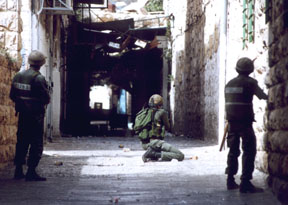|
|
|
UN Urged to Investigate Israeli Violations of Palestinian Rights
Tuesday, October 10, 2000: The United Nations High Commission on Human Rights meets in Geneva to decide whether to hold a Special Session to discuss Israeli human rights violations in the latest confrontations with Palestinian demonstrators. MADRE, the international womenıs human rights organization, has launched a call for the Special Session and for an independent inquiry into the excessive use of force and other violations by Israeli troops. The following letter to UN Secretary General Kofi Annan, UN High Commissioner for Human Rights Mary Robinson and the 53 Members of the Commission, was issued by MADRE and signed by 200 individuals and organizations worldwide. To: the Honorable Kofi Annan, United Nations Secretary General and the Honorable Mary Robinson, United Nations High Commissioner of Human Rights We know that you share our deep concern about the human rights crisis in the West Bank, Gaza and Israel. As individuals and members of organizations committed to upholding human rights, we are particularly disturbed by the following: The use of excessive and indiscriminate force by the Israeli military As of October 9, at least 85 Palestinians have been killed and over 3,000 wounded by Israeli forces using rubber-coated bullets, live ammunition, helicopter gunships, tanks and anti-tank missiles. On October 2, ten Palestinians were killed and dozens wounded when Israeli forces fired missiles at unarmed demonstrators in Gaza. Ambulance drivers and emergency healthworkers clearly identified as medical personnel have been among those injured and killed. In an interview given to The New York Times (10/4/00), Dr. Khaled Qurie, director of Makassed Hospital in East Jerusalem, reports an unusually high number of upper body injuries to the head, neck, chest and abdomen compared with previous clashes. Doctors at St. Johnıs Hospital in Jerusalem have treated 18 Palestinians shot in the eye at close range with rubber-coated bullets. This, despite the fact that Israeli troops are trained to fire these bullets from at least 100 feet away and only at the feet and legs. International standards dictate that security forces may use firearms only when lives are threatened and other options are unavailable. In these confrontations, Israeli forces have apparently relied on deadly force as a first, rather than last, resort. Palestinian human rights organizations report that numerous people who were seeking shelter from the clashes have been among those fatally wounded by indiscriminate Israeli gunfire. The targeting of children with lethal force The Union of Palestinian Medical Relief Committees reports that a full 44% of the wounded are children under the age of 18. Mohammed Al-Dura, the 12-year-old boy who was shot and killed as television cameras filmed his fatherıs desperate attempts to protect him, is only the most visible of the victims. Sixteen other children have been killed, the youngest being 18-month-old Sara Abdel-Azeem. Ten-year-old Mohammed Jaber Raafi was killed by an explosive, high velocity bullet to the head. This type of bullet is designed to shatter upon impact in order to maximize injury and is outlawed under international conventions. In addition to these fatalities, three other children have been declared clinically dead after being shot by Israeli troops and at least 12 children have been shot in the eyes by Israeli soldiers. Curfews and Attacks on Palestinian Homes Defense of Children International reports that in Gaza, Ramallah, Hebron, Nablus and Bethlehem, Israeli troops have occupied Palestinian homes, turning them into military installations and terrorizing families in the process. In one case, a family of seven in Beit Sahour was imprisoned in their bathroom for five hours while soldiers fired with live ammunition from their rooftop at demonstrators. The familyıs home was completely destroyed as a result. Numerous other houses have been badly damaged by Israeli gunfire, including 500 mm rounds and ammunition from helicopter gunships. In several West Bank villages, Israeli troops have cut off electricity and entered and ransacked the homes of people who have fled the fighting. Parts of the West Bank, including the Old City of Hebron and the northern village of Al-Aqaba, have been under 24-hour curfew since October 1. Tens of thousands of Palestinians living in these areas are prevented from leaving their homes for any reason, including to seek medical care. Residents are reporting food shortages which are likely to worsen as Israelıs full closure of the West Bank and Gaza further curtails Palestinian freedom of movement. Despite numerous international attempts to resolve this crisis, violence continues to rage throughout the affected areas. Around the world, people have great faith in the Office of the UN High Commission for Human Rights. We, too, are placing our hopes in the High Commission to play a positive role in ending this violence and holding perpetrators accountable for abuses of human rights. It is our view that the conduct of the Israeli military violates numerous international human rights standards, including Articles 9, 10 and 11 of the United Nations Basic Principles on the Use of Force and Firearms by Law Enforcement Officials and Articles of the Fourth Geneva Convention governing the treatment of civilians under military occupation. In light of the ongoing violence directed at Palestinian civilians by Israeli military forces, we urge you to convene a Special Session of the United Nations Commission on Human Rights to discuss the violence in the Occupied Territories and Israel. We also urge the establishment of an international inquiry into the unlawful use of force and other human rights violations committed by Israeli forces. . . .nd to poverty. These foot-soldiers are mobilisi |

